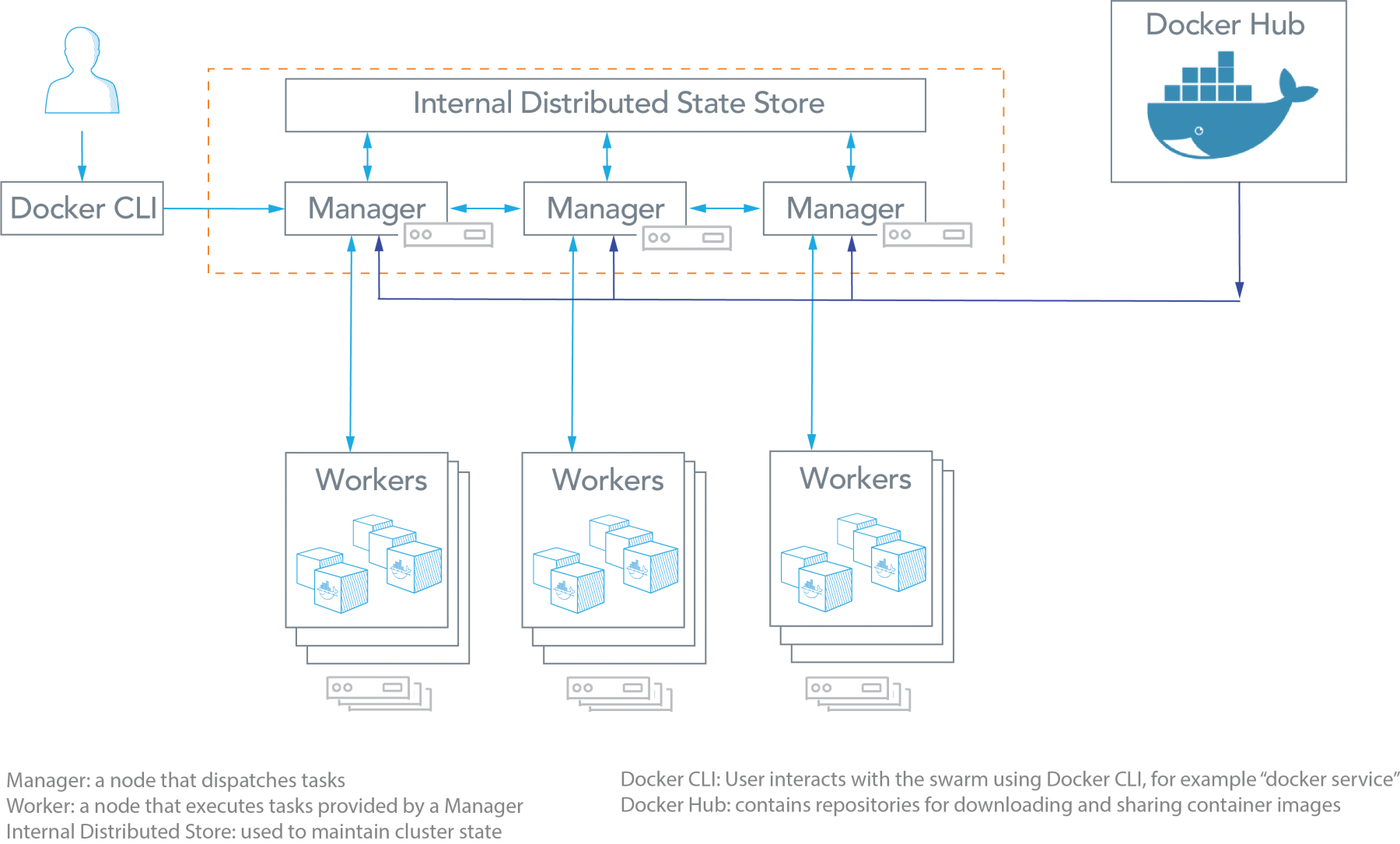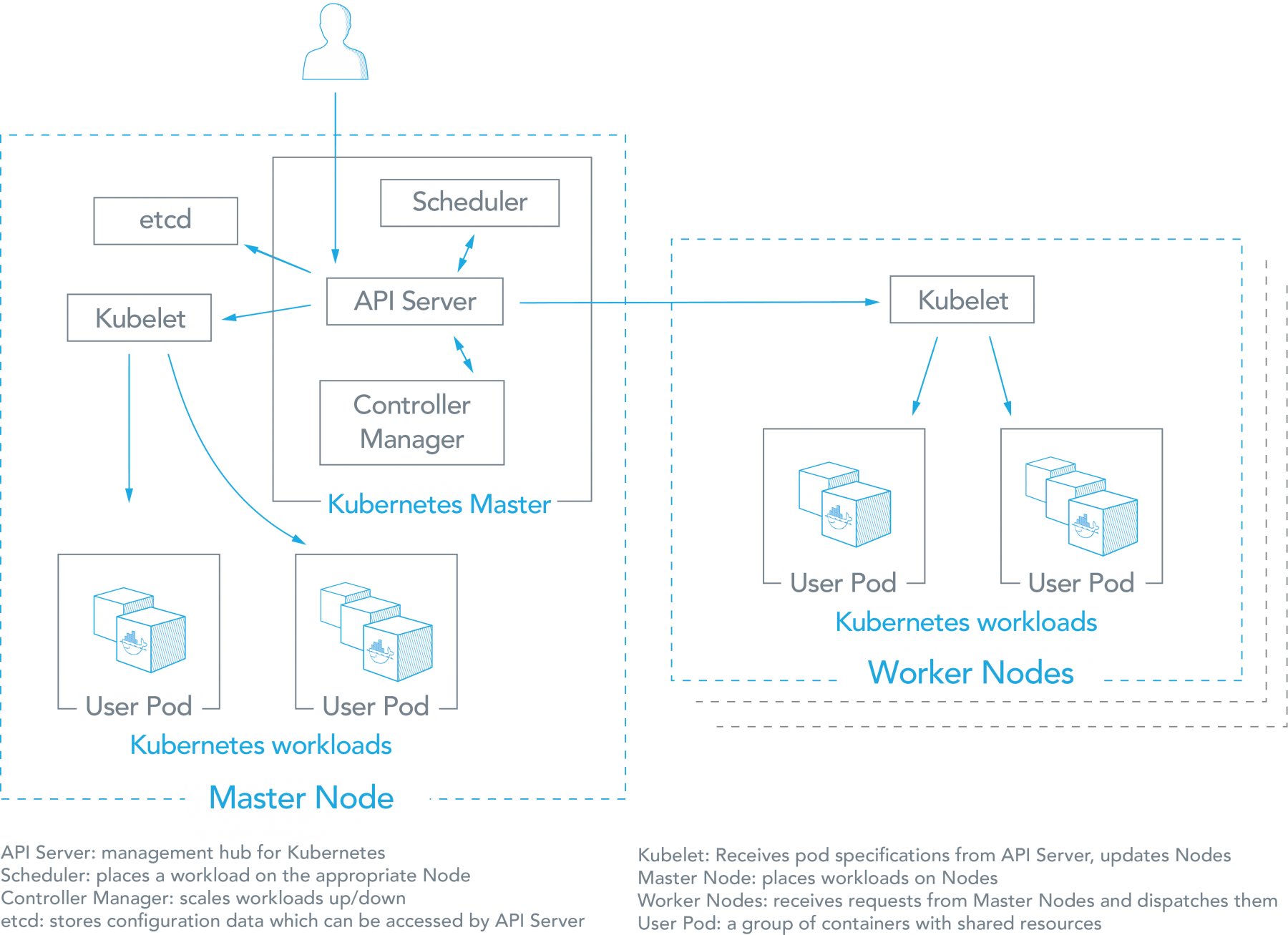Overview
TL;DR - Kubernetes is a tool to deploy application in the form of containers on a set of machines that are configured as worker nodes in a cluster.
So, lots of people think Kubernetes is the next orchestrator people should learn after Swarm. This article will show you what K8s is and try to compare K8s to Swarm side by side.
Kubernetes essentially is a set of APIs that run on apps in containers to manage a set of servers and then execute your containers on Docker, by default. It can run other container runtimes that aren't Docker, like containerd.
- Container Orchestration = Make many servers act like one
- Released by Google in 2014, maintained by large community
- Provides API/CLI to manage containers across servers
- It gives you a set of those APIs/CLI tools to deploy and maintain the same server infrastructure that you would have similar to Swarm.
- Kube control is the tool that you use like Docker command when using Docker. Kube control is the official name of Kubernetes tool. (You may heard other unofficial names like kube cuddle, or koob control)
- Many clouds provide it for you
- Many vendors make a "distribution" of it
- Similar to the concept of Linux distributions. In the Linux world, there's the same Linux kernel running on all these different distributions, whether it's Ubuntu, or CentOS, or Amazon Linux. All these different distributions package up their own set of tools that a lot of us prefer one or the other. That's the same way with Kubernetes now.
- All of those are providing a upstream version of the pure, open source Kubernetes. Then they layer on top of it all their own extra stuff to your benefit.
- Provide a set of those APIs and command line tools to deploy and maintain the same server infrastructure
K8s distribution
Kubernetes is an open source platform. You might think, then, that it's a vendor-agnostic platform, meaning that you can easily move from one Kubernetes implementation to another. The ideal case is that you can take your workloads and your YAML files that design your infrastructure, and you can move those from one Kubernetes vendor to another and they should work out-of-the-box for most things.
But you'd be wrong. The reality is that many Kubernetes solutions – in particular, those that are tied to a specific public cloud – are much less vendor-agnostic than you might think.
Fortunately, this doesn't mean that you can't take advantage of the public cloud as a Kubernetes hosting solution if you want to avoid lock-in. You can, but you have to design your Kubernetes strategy in a way that frees you from being locked into a particular cloud provider's Kubernetes service while still enabling you to enjoy the advantages of cloud-based Kubernetes.
Vendor product
When you get a vendor solution,they will provide custom features like authentication solutions, web administration and networking etc. Here are the list of the popular kubernetes distributions. You may check the full list on this page
- Rancher
- Red Hat OpenShift
- Mirantis
- VMWare Tanzu
- Docker Kubernetes Service (DKS)
- Amazon Elastic Kubernetes Service (EKS)
- Elastisys Compliant Kubernetes
Use raw GitHub upstream version of Kubernetes only for learning how K8s works. Because one of the things about Kubernetes that's different from Swarm is that it needs a lot of things added to it to really make it easy to use out-of-the-box.
Swarm vs K8s
TL;DR - Swam is easier to deploy/manage whilist Kubernetes has more features and flexibility
They're both container orchestrators that run on top of a container runtime (check this for more explanation about container runtime).
Swarm architecture:

K8s architecture:

Source: Kubernetes vs Docker Swarm
Advantages of Swarm
- Comes with Docker, single vendor container platform. Which means that the container runtime, and the orchestrator, are built by the same company.
- Easiest orchestrator to deploy/manage yourself
- 80/20 rule - It has 20% of the features of Kubernetes, and that solves 80% of the use cases for running containers and orchestration. (the number is just a feeling, not a scientific comparison)
- Runs anywhere Docker does:
- local, cloud, datacenter
- ARM (which means Embedded, IoT, Raspberry Pi), Windows, 32-bit
- Secure by default
- it ensures mutual TLS authentication. It encrypts the control plane and it encrypts the database to protect your secrets
- Easier to troubleshoot by using same Docker's deamon logs, same Docker's log command
In general, Swarm is the tool that I recommend when people start out and they're starting small. Maybe they're a single person, or just one, two, or three people in their team, and they need to see if a small, simple orchestrator is going to work for them. I always recommend Swarm first, unless you know absolutely you have to use Kubernetes. Once you think you've hit some limits in Swarm and you think that you can't quite get what you need out of it, that's when it's time to look at Kubernetes.
Advantages of K8s
- Clouds will deploy/manage Kubernetes for you, you just need to run your apps on there using Kubernetes deployment files
- Infrastructure vendors are making their own distributions
- "Kubernetes first" vendor support - For example, with Jenkins,from the company CloudBees. They give you Kubernetes tooling and samples on how to run it if you buy their enterprise solution, though it doesn't mean you can't run Jenkins on Swarm.
- "No one ever got fired for buying IBM" (A terms that we use to describe the era when people couldn't decide on which vender to work with, they choose IBM)
- Picking solutions isn't 100% rational
- Trendy, will benefit your career
- CIO/CTO Checkboxs